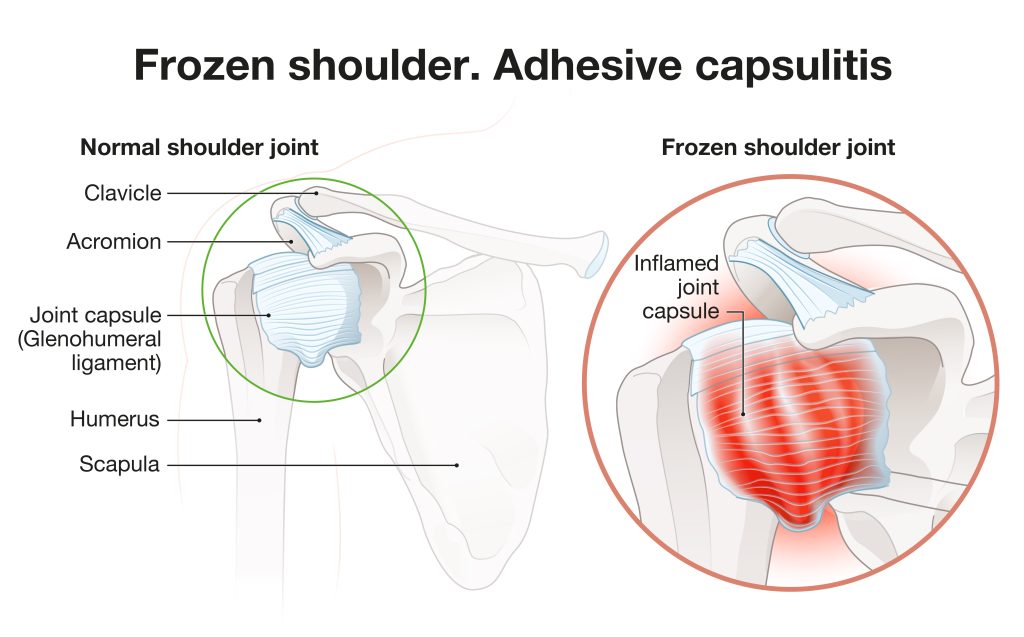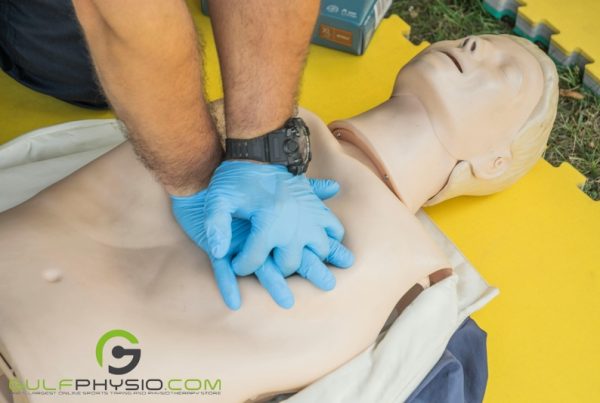
Frozen shoulder is a condition that can be highly frustrating for people who suffer from it. If you’re unfamiliar with it, frozen shoulder is a condition where the shoulder joint becomes immobilized due to a rigid joint. As a result of this condition, you may experience pain and difficulty doing everyday activities. This condition will affect your range of motion.
Understand frozen shoulder, including the causes, symptoms, and treatments. With this guide, we hope you get the treatment you need and get your life back as usual as possible.
What exactly is frozen shoulder?
Frozen shoulder is a form of shoulder pain that can limit movement in the shoulder joint. It’s also called adhesive capsulitis and frozen shoulder syndrome. In addition to stiffness, pain, and decreased range of motion, the condition causes pain in the shoulder joint. This can make it challenging to raise your arm above your head or reach behind your back. Frozen shoulders can be extremely painful.

Frozen shoulder typically affects people over 40 years old, but it can occur at any age. It usually develops gradually over several weeks or months, but sometimes it comes on suddenly. The symptoms typically aren’t permanent, but they can last for years if not treated properly. A few people have more than one episode of frozen shoulder during their lifetime.
What causes frozen shoulder?

The cause of frozen shoulder is unknown. It may be related to a traumatic injury or repetitive strain. The affected joint becomes inflamed and loses its ability to move freely due to scarring within the joint capsule. As a result, your arm may feel stiff and painful when you lift or rotate it.
Doctors think it’s related to inflammation and scarring of the capsule surrounding the joint (capsulitis). An immune response to infection or irritation causes swelling and reddening of the tissues. Capsulitis occurs when this inflammation becomes chronic (persistent).
Symptoms of frozen shoulder
People with frozen shoulders may experience a variety of symptoms, but they usually include:
- Pain in the shoulder area that worsens with activity
- Swelling around the joint
- Stiffness in the night or early morning with difficulty moving your arm
- Mild weakness in the affected shoulder when it has been painful for some time
- Loss of range of motion (ROM) in all directions. Most common are reaching behind your back (retraction) and raising your arm towards the ceiling (abduction)
- Inability to lift objects weighing less that five pounds without pain
The three stages of frozen shoulder
The three stages of frozen shoulder are:
- Freezing stage is when you first notice symptoms and your arms feel stiff. This stage can last for several weeks or months. The muscle becomes inflamed and unable to move. Due to this, the muscles become frozen, which means they don’t receive enough oxygen or blood flow.
- Frozen stage: The frozen stage lasts longer than one year after the freezing stage ends; however, it’s usually less than two years. In this stage, you have decreased range of motion and pain with movement. This stage is the most dangerous as the painfully tight joint capsules has the potential to be damaged.
- Thawing stage: This occurs when the range of motion improves, and symptoms lessen or disappear completely (sometimes permanently).
Frozen shoulder treatment
The main treatment methods for frozen shoulder are:
Physical Therapy
Frozen shoulder is a condition that physical therapy can treat. The modalities used will depend on the severity of the condition and how long it has been present.
- A type of electrical stimulation known as TENS (transcutaneous electrical nerve stimulation) can decrease pain and inflammation by using mild electrical currents.
- Ultrasound uses sound waves to heat tissue, which can help increase blood flow, relax muscles, and reduce pain.
- Pain and muscle spasms associated with frozen shoulder may be relieved with heat or cold therapy.
- Try alternating between hot packs and ice packs every few hours, or use a heating pad at night when you sleep.
- You can also try applying heat before exercising, which may help improve blood flow to your shoulder muscles and reduce spasms during exercise sessions.
- Take a warm bath or shower (with warm water only). You can add Epsom salts if desired. This technique helps draw fluid from swollen tissues into surrounding spaces so that swelling may decrease faster. Consequently, nerve pressure is relieved, and circulation is improved, which speeds up the healing process.
Physical therapy exercises are often used in combination with these modalities to increase the range of motion and strength at affected joints.
Physical therapy exercises/ Home exercises
A home exercise program involves specific exercises you do to improve your shoulder strength and flexibility.
- Finger ladder exercises involve using different finger positions to stretch the affected muscles. This exercise can help reduce pain and improve the range of motion in your shoulder. Hold one arm straight out in front of you at shoulder height and move only fingers up and down as if they were ladders.
- Pendulum swing exercises: Another excellent exercise for frozen shoulders is pendulum swinging with a kettlebell. This exercise focuses on strengthening both arms equally while providing gentle resistance. The key here is to keep the kettlebell moving in a circular motion as you swing back and forth.
- Towel exercises: You can use a towel to perform various activities that will help stretch and loosen your muscles. Here are some examples:
- Hold the towel in your hand at arm’s length and extend your arm forward as far as possible.
- Then, slowly pull the towel back towards your body.
- Repeat this motion several times.
- Foam roller massage: This is an excellent way to relieve pain and tension in your shoulders. This massage involves applying gentle pressure to the muscles and fascia surrounding the joint, which helps to release stress and relieve pain. Additionally, it improves joint mobility, range of motion, and circulation.
- Umbrella exercises: This is an effective way to stretch out the upper arm and help improve circulation.
Click here to learn more about frozen shoulder exercises.
Steroid injections
These injections can help reduce inflammation and pain so you can start performing daily activities more efficiently.
Medications
In addition to physical therapy methods, your doctor may prescribe painkillers or anti-inflammatory drugs to help relieve your symptoms. Some patients also experience relief from their frozen shoulder by using a splint or brace during recovery.
Dry needling
Another standard treatment is dry needling, which uses needles to stimulate acupuncture points in the body. This painless procedure helps reduce muscle spasms and increases blood flow to the area.

Surgery
Surgery is often necessary if conservative treatment methods don’t work. The surgery will remove any damaged tissue that’s causing problems with movement or pain your shoulder.
Conclusion
No single treatment works for frozen shoulder, but various treatments may help reduce symptoms and help restore functionality. In most cases, physical therapy and pharmaceuticals are used in conjunction with each other. Physical therapy helps to improve ROM, while medications ease inflammation and pain. Surgery may be necessary if physical therapy isn’t successful or if there’s severe damage to your muscles.


